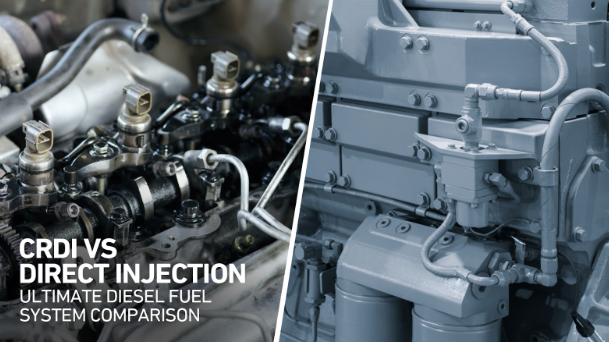Direct Injection vs Common Rail Direct Injection

Ever since its invention in 1897 by Rudolph Diesel, diesel engines have seen numerous improvements over the years. Right from its efficiency to emission, the performance of diesel engines has improved by leaps and bounds. Among the several advancements, the injection system of diesel engines has seen rapid improvements over the years. From the conventional direct fuel injection systems to the modern CRDI (Common Rail Direct Injection), diesel engine injection systems have leveraged technology to their advantage.
Through this article, we will talk in-depth about the core differences between injection systems and their pros and cons. Let’s get started.
Understanding Direct Injection System
As the name suggests, a direct injection system involves precisely delivering fuel directly into the combustion chamber. Bypassing the older method where fuel was first sprayed into a pre-combustion chamber, this method of fuel injection ensures efficient combustion.
The entire system is designed in such a way that the correct amount of fuel is injected into the combustion chamber, leading to an improvement in the engine’s performance. In other words, direct injection focuses on delivering fuel straight to where the engine needs it most, in the appropriate amount.
Pros of Direct Injection System
Unlike older engines that relied on pre-combustion chambers, the direct injection system offers several key advantages. Some of them are listed as under :
Improved Fuel Efficiency:
Direct injection systems offer precise control over fuel efficiency. This eventually leads to better mileage and reduced fuel consumption.
Enhanced Power Output:
In contrast to traditional indirect injection systems, by injecting fuel directly into the combustion chamber at high pressure, the engine can generate more power.
Better Cold Start Performance:
Direct injection systems are tuned to operate efficiently even in cold conditions, ensuring a quicker engine startup and smooth operation. It is due to this reason that this type of injection is heavily used in off-highway diesel engines.
Cons of Direct Injection System
Engine Knocking:
In some scenarios, direct injection engines can be more prone to engine knock under certain operating conditions. This usually occurs due to the distribution and timing of the fuel injection, which affects combustion stability.
Carbon Build-up:
Direct injection engines are prone to carbon deposits forming on the intake valves and ports because the fuel no longer washes over these areas during the intake stroke, which is common in port fuel injection systems. This can affect engine performance over time and may require periodic cleaning.
Increased Particulate Emissions:
DI engines can produce higher levels of particulate emissions. This happens due to how fuel is injected directly into the combustion chamber leading to incomplete combustion under certain conditions.
Now that we know about the working pattern of the direct injection system, let us understand the workings of CRDI systems and find out how they stand up against the direct injection systems.
Understanding Common Rail Direct Injection Systems
CRDI uses a high-pressure common rail and injects fuel directly into the combustion chamber of each cylinder. This ensures that fuel is atomized precisely thereby resulting in efficient combustion.
Common Rail Direct Injection Systems can precisely control the timing and amount of fuel injected into the combustion chamber. Along with this, they can even adjust fuel delivery according to engine load and speed.
Furthermore, CRDI engines are known for their smoother operation and reduced noise levels compared to older diesel engines. The high-pressure fuel injection ensures engine clatter is kept at lower levels.
Additionally, CRDI technology also supports the use of alternate fuels and can be integrated with advanced engine management systems. These types of injection systems are prominently used in heavy-duty diesel engines.
Read Also: Top Wholesale B2B Marketplaces in the UAE: Connecting Businesses to Quality and Variety
Pros of Common Rail Direct Injection Systems
Precise Fuel Delivery:
The fact that a CRDI utilises a high-pressure common rail to store fuel, and eventually delivers to each injector at precise intervals allows for better fuel atomization.
Better Fuel Efficiency:
When compared with direct fuel injection systems, CRDI has better control over fuel delivery. This results in an improved fuel efficiency.
Lower Emissions:
A better fuel efficiency courtesy of clean combustion leads to a drastic reduction in the amounts of particulate matter and nitrogen oxides.
Quiet in Operation:
Another advantage that CRDI has is they minimize engine noise and vibration compared to direct injection systems.
Cons of Common Rail Direct Injection Systems
Complexity and Cost:
One of the biggest drawbacks of CRDI is its complex design, sophisticated electronic controls, and high manufacturing cost. In complete contrast to this, direct injection systems are much simpler in their design, thereby having lower initial costs.
Maintenance and Reliability:
The high-pressure components of CRDI systems, such as injectors and the common rail, may require more frequent maintenance and are sensitive to fuel quality. Failure in these components can be costly to repair. Direct injection on the other hand requires less frequent maintenance compared to CRDI systems.
Dependency on Fuel Quality:
CRDI systems are more sensitive to fuel quality. Poor fuel quality can lead to injector clogging, reduced performance, and higher maintenance costs. While also affected by fuel quality, DI systems may have fewer issues with fuel-related problems compared to CRDI systems due to their simpler design.
Environmental Impact During Manufacturing:
The production of CRDI systems involves more complex manufacturing processes and potentially higher energy consumption compared to DI systems, which can have environmental implications. In contrast to this, direct injection systems may have a lower environmental footprint during manufacturing courtesy of their simpler production processes.
To conclude, it can be said that while both CRDI and DI have their respective pros and cons, one must consider application, needs, and priorities while zeroing in on the type of injection system. When it comes to efficiency, CRDI rules the roost. However, when it comes to simplicity in design, DI wins the race. However, it must be noted that the majority of diesel engine manufacturers in India in today’s time are more inclined towards usage of CRDI.



